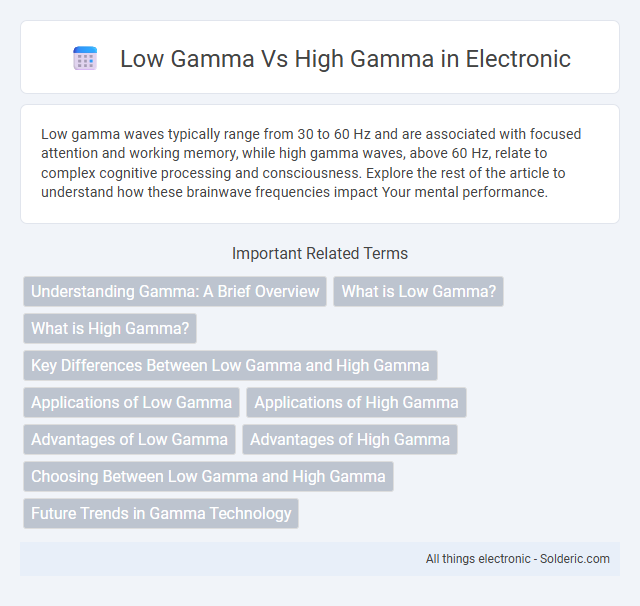Low gamma waves typically range from 30 to 60 Hz and are associated with focused attention and working memory, while high gamma waves, above 60 Hz, relate to complex cognitive processing and consciousness. Explore the rest of the article to understand how these brainwave frequencies impact Your mental performance.
Comparison Table
| Feature | Low Gamma | High Gamma |
|---|---|---|
| Frequency Range | 30-50 Hz | 50-100 Hz |
| Brain Activity | Associated with sensory processing and attention | Linked to higher cognitive functions and memory encoding |
| Measurement | EEG/MEG signals in the low gamma band | EEG/MEG signals in the high gamma band |
| Applications | Focus, sensory perception studies | Cognitive neuroscience, memory research |
| Significance | Supports basic neural synchronization | Indicates complex neural processing |
Understanding Gamma: A Brief Overview
Gamma brain waves, ranging from low gamma (30-50 Hz) to high gamma (above 50 Hz), play crucial roles in cognitive functions such as perception, memory, and information processing. Low gamma waves are often associated with integrating sensory input and conscious attention, while high gamma waves correlate with higher-order cognitive processes like problem-solving and neural synchronization across brain regions. Understanding these gamma frequencies helps you optimize mental performance and enhance brain function through targeted neurofeedback or cognitive training.
What is Low Gamma?
Low Gamma refers to brainwave frequencies ranging from approximately 30 to 50 Hz, associated with cognitive processes such as attention, memory encoding, and sensory perception. These neural oscillations play a critical role in information processing by facilitating communication between different brain regions during complex mental tasks. Research links Low Gamma activity to enhanced learning capabilities and the integration of sensory inputs for coherent perception.
What is High Gamma?
High Gamma refers to brainwave frequencies typically ranging from 60 to 100 Hz, associated with higher cognitive functions like memory processing, attention, and consciousness. It plays a crucial role in neural synchrony, enabling complex information integration across different brain regions. Unlike Low Gamma, which operates between 30 to 50 Hz and is linked to sensory processing, High Gamma is more involved in advanced neural activities underlying learning and perception.
Key Differences Between Low Gamma and High Gamma
Low Gamma waves typically range from 30 to 50 Hz and are associated with memory processing and sensory perception, while High Gamma waves span 50 to 100 Hz and are linked to higher cognitive functions such as attention, working memory, and information integration. Low Gamma activity is often observed during relaxed states with focused mental activity, whereas High Gamma demonstrates increased presence during complex problem-solving and intensive cognitive tasks. The distinction in frequency bands corresponds to their specific roles in neural synchronization and brain connectivity, impacting neurological and psychological processes differently.
Applications of Low Gamma
Low Gamma frequencies (30-50 Hz) are predominantly utilized in cognitive processes such as attention, memory encoding, and sensory perception, making them critical in neurofeedback therapy and brain-computer interface applications. These oscillations support neural synchrony that enhances learning and information processing, often targeted in treatments for disorders like ADHD and schizophrenia. The specific modulation of Low Gamma waves enables improvements in cognitive performance and emotional regulation, highlighting their therapeutic potential in neuroscience and clinical settings.
Applications of High Gamma
High Gamma waves, ranging from 60 Hz to 200 Hz, are closely associated with advanced cognitive functions such as heightened perception, memory processing, and problem-solving abilities. These brainwaves play a crucial role in activities requiring intense focus, learning enhancement, and sensory integration, making them valuable in neurofeedback therapy and cognitive training programs. High Gamma is also linked to states of peak mental performance and consciousness, utilized in meditation practices and brain-computer interface technologies for improving human-machine interaction.
Advantages of Low Gamma
Low Gamma frequencies, typically ranging from 30 to 50 Hz, offer advantages such as enhanced cognitive processing and memory recall due to their association with focused attention and information integration. These lower gamma waves promote neural synchronization that supports learning and problem-solving, reducing mental fatigue compared to higher gamma frequencies. You can leverage Low Gamma activity to sustain mental clarity and improve overall brain function during complex tasks.
Advantages of High Gamma
High Gamma frequencies offer superior spatial resolution and faster data transmission compared to Low Gamma, making them ideal for advanced neuroimaging and brain-computer interface applications. These advantages enable more precise mapping of neural activity, enhancing the accuracy of your cognitive and neurological assessments. Enhanced signal clarity and reduced latency in High Gamma waves contribute significantly to improved performance in real-time neural processing tasks.
Choosing Between Low Gamma and High Gamma
Choosing between Low Gamma and High Gamma depends on the desired trading frequency and risk tolerance. Low Gamma positions offer more stability with slower price movements and less sensitivity to changes in the underlying asset, while High Gamma positions provide greater profit potential through rapid price changes but at the cost of increased volatility and risk. Traders aiming for conservative strategies typically prefer Low Gamma, whereas those seeking high reward in short-term trading favor High Gamma exposure.
Future Trends in Gamma Technology
Advancements in gamma technology are steering towards enhanced resolution and sensitivity in both low gamma and high gamma spectrum applications, facilitating breakthroughs in medical imaging and industrial inspection. Future trends emphasize integrating AI algorithms for real-time data analysis and predictive diagnostics, particularly in high gamma radiation environments where precision is critical. The development of hybrid detectors combining low and high gamma detection capabilities aims to create multifunctional devices with broader applicability and improved efficiency across nuclear medicine and security sectors.
Low Gamma vs High Gamma Infographic

 solderic.com
solderic.com